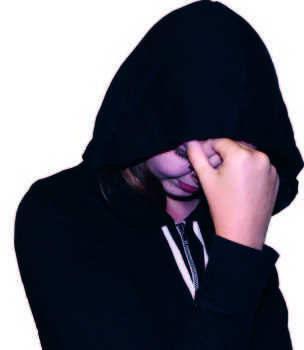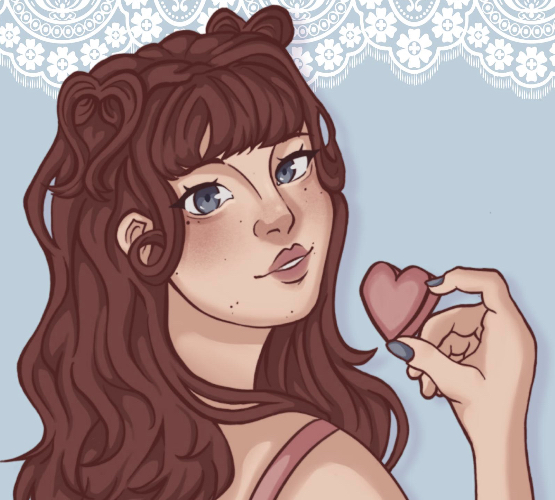Senior Sabrina Renteria started it in the eighth grade. She did it because she was bored. She did it because she had seen it before. She did it to see if she could.
Sitting in her friend’s bedroom, Sabrina watched as the girl pulled out some box-cutters. She handed one to Sabrina. They talked it over. Sabrina knew her older sister used to cut herself sometimes. She had even seen people do it on TV and in movies. The two girls rolled up their sleeves. Sabrina placed the sharp blade to her skin and drew a thin, pink line up her arm. It was nothing more than a cat scratch.
But once high school started, the cuts got deeper.
***
Ugly. Weird. Loser. These are just some of the words students called her. They shoved her into lockers. They said she had buck teeth. When she cut her hair short, they called her a dyke.
Scissors. Lighters. Erasers. These are just some of the things she used to hurt herself. She used anything she could find. She wore long sleeves in the summer. Even though she knew hurting herself was unhealthy, she didn’t want to stop.
“I didn’t want to find something else as a coping mechanism,” Sabrina said. “I didn’t want to have to do it the healthy way. It was just the easy way.”
Each cut, burn, scrape let her forget. It allowed her to focus on the physical pain, not the stresses she felt from school and bullying.
Only her close friends knew she struggled with hurting herself. The friend who was present the first time she cut herself had even told her to stop. But Sabrina couldn’t. When she finally confessed to her mom, Eileen Renteria, six months into her freshman year, it was a cry for help.
“It wasn’t that I wanted to tell her,” Sabrina said. “It was because I needed help. I had to tell her.”
At first, Eileen thought the behavior was just a way to get attention. She was angry. She grounded Sabrina.
“But then after I started reading about it, I realized that that’s not the right approach,” Eileen said. “I realized that it’s not just an attention-getter or just trying to be cool. It’s a coping mechanism.”
During the spring of her freshman year, Sabrina spent several weeks in an outpatient program at a psychiatric hospital. From 9:00 a.m. to 5:00 p.m. each day, she took part in group therapy and met others who were dealing with similar struggles.
“There was a point where I felt like nobody really understood me, so when I went there, it helped me realize I wasn’t being dramatic,” Sabrina said.
She also found a new way to deal with the stress she felt – working with beads. Instead of hurting herself, she began making bracelets from an elastic string and colorful beads.
But harming herself didn’t end just like that. It had become an addiction.
“There have been times when I’ve been extremely happy, but I would still want to do it because I’m addicted to it,” Sabrina said. “There was a point when I was like ‘I can’t stop.’”
One night when she was still enrolled in the program, she did it again. She grabbed a pair of scissors and drew a cut on her thigh.
“[The program] was kind of like a stepping stool, and I thought I was going to get to the other side,” Sabrina said. “But it wasn’t that easy.”
***
After several weeks of the program, Sabrina seemed happy. She spent time with her family. She didn’t isolate herself.
But as stress, bullying and anxiety increased during her sophomore year, so did Sabrina’s self-destruction. She felt pressure to be a good friend, pressure to be a good girlfriend, and she didn’t feel good enough.
More cuts. More burns. More scars.
“It’s like a drug addict slipping up,” Sabrina said. “I did feel bad, but it wasn’t enough to make me stop.”
And this time, she took it one step further. She began cutting her wrists. She knew what that would mean. That it would be difficult to cover up. That it was suicidal. After several particularly bad cuts on her wrist and arm, Sabrina came clean to her mom. She told her she wanted to kill herself.
From the spring of sophomore year to the following August, Sabrina was admitted to another hospital for inpatient treatment. This time, she was gone for five months. Her days consisted of group therapy, skill building and recreational activities. She met people who were also dealing with depression and was challenged to overcome fears through ropes course exercises, sky lining and climbing to the top of a totem pole.
Eileen said it was difficult to be away from her daughter. She drove the six-hour stretch to visit Sabrina about three times a month. Each time, Sabrina asked to come home.
“I’m fine. I don’t need to be here,” she would plead.
When her time here ended, Sabrina returned home to face her junior year. She received antidepressants and anti-anxiety medication as well.
“I was away for five months, so everyone expected me to be good and happy,” Sabrina said. “But it doesn’t work like that.”
When she came back to school with shorter hair and a more masculine clothing style, the bullying increased. Verbal insults turned into physical harassment.
One day when one of the hallways was empty, Sabrina stood by the stairwell before going to class. Another student approached her. “Hey, fag,” he said. The student pushed her to the ground and kicked her. “You should be able to take it,” he said. “You dress like a guy.”
Sabrina didn’t understand. She didn’t see why someone who didn’t know her would do that.
“It made me feel like I should not be alive,” Sabrina said. “It made me feel like I could not be who I actually wanted to be without everyone else in the world judging me.”
The bullying also escalated to being kicked out of locker rooms for not looking like a girl. She was called “faggot” almost every day in the hallways. Sabrina sunk deeper into her depression, and the cycle continued. Depression. Cutting. Hiding the scars.
Eventually, physical pain wasn’t enough anymore.
***
That night was a blur. She had stayed home from school all day thinking it through. She was tired of being depressed. She was done.
Sabrina found three bottles of her old medication. It was enough to kill her. She took them to her bedroom and let the pills slide down her throat. The anxiety, the bullying, the stress had all led up to this moment.
Several empty pill bottles later, Sabrina received a phone call from a friend. She told her friend what she had done. The friend threatened to call the cops if Sabrina didn’t tell her mother. The pills had taken effect. But Sabrina made her way down the stairs to her mom.
For Eileen, that moment was surreal. Time stood still. She immediately thought of the neighbor boy across the street who killed himself a few years back. She remembered the heartache his parents went through. She wondered if she too would have to bury her child.
“Initially, I didn’t know,” Eileen said. “She was dozing off…I was panicked.”
An ambulance took Sabrina to a hospital, and doctors revived her. They told her if she hadn’t answered the phone, if she hadn’t told her mom, the pills would have killed her.
***
After her suicide attempt, Sabrina was admitted to a medical hospital and later another outpatient hospital.
Instead of returning to Marcus for her senior year, Sabrina is now attending the Learning Center so she can catch up on classes she missed and graduate early.
Even though she’s been to several hospitals, seen numerous psychologists and taken different medications, Sabrina’s battle isn’t over yet. She still has urges to hurt herself.
“I’m doing better with it,” Sabrina said. “But I still have a lot of work to do.”
She dreams of a day when she has more responsibilities so she won’t have time to focus on her depression. And right now, she’s on her way. For the first time, Sabrina has acquired a job. She now has a paycheck to look forward to each week and something to keep her busy. She sees a therapist once a week, and she’s also gotten more involved at school by joining a club.
But she’ll always have the scars. Scars that remind her what she’s missed out on.
“I just think it’s not worth it,” Sabrina said. “I missed out on prom last year because of it. I have missed out on being happy in high school and making a lot of good friends.”
Sabrina said she hopes to help others like her in the future. She now wants to study psychology and someday help teens who are dealing with self-harm.
“I would like to see her focus on positive outlets and positive things to make herself feel good and not think ‘oh, I’m weird or strange…’” Eileen said. “I’m hoping that when she gets into psychology, she will learn these things.”
According to Eileen, a lack of self-worth and activities can contribute to self-harm tendencies.
“It seems to me that it might be more of an epidemic for those kids who don’t have a lot of social activity going on like healthy clubs or sports, kids that aren’t involved in activities that build self-esteem,” Eileen said.
For students currently struggling with self-harm, Sabrina recommends talking to someone who can help. In 10 years, she said, the scars won’t be worth it.




